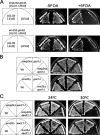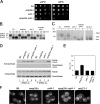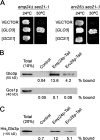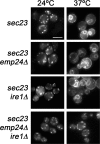The yeast p24 complex is required for the formation of COPI retrograde transport vesicles from the Golgi apparatus
- PMID: 18283113
- PMCID: PMC2265561
- DOI: 10.1083/jcb.200710025
The yeast p24 complex is required for the formation of COPI retrograde transport vesicles from the Golgi apparatus
Abstract
The p24 family members are transmembrane proteins assembled into heteromeric complexes that continuously cycle between the ER and the Golgi apparatus. These cargo proteins were assumed to play a structural role in COPI budding because of their major presence in mammalian COPI vesicles. However, this putative function has not been proved conclusively so far. Furthermore, deletion of all eight yeast p24 family members does not produce severe transport phenotypes, suggesting that the p24 complex is not essential for COPI function. In this paper we provide direct evidence that the yeast p24 complex plays an active role in retrograde transport from Golgi to ER by facilitating the formation of COPI-coated vesicles. Therefore, our results demonstrate that p24 proteins are important for vesicle formation instead of simply being a passive traveler, supporting the model in which cargo together with a small GTPase of the ARF superfamily and coat subunits act as primer for vesicle formation.
Figures





Similar articles
-
The p24 Complex Contributes to Specify Arf1 for COPI Coat Selection.Int J Mol Sci. 2021 Jan 3;22(1):423. doi: 10.3390/ijms22010423. Int J Mol Sci. 2021. PMID: 33401608 Free PMC article.
-
Trs65p, a subunit of the Ypt1p GEF TRAPPII, interacts with the Arf1p exchange factor Gea2p to facilitate COPI-mediated vesicle traffic.Mol Biol Cell. 2011 Oct;22(19):3634-44. doi: 10.1091/mbc.E11-03-0197. Epub 2011 Aug 3. Mol Biol Cell. 2011. PMID: 21813735 Free PMC article.
-
Auxilin facilitates membrane traffic in the early secretory pathway.Mol Biol Cell. 2016 Jan 1;27(1):127-36. doi: 10.1091/mbc.E15-09-0631. Epub 2015 Nov 4. Mol Biol Cell. 2016. PMID: 26538028 Free PMC article.
-
[The p24 family proteins--regulators of vesicular trafficking].Postepy Biochem. 2010;56(1):75-82. Postepy Biochem. 2010. PMID: 20499684 Review. Polish.
-
Formation of COPI-coated vesicles at a glance.J Cell Sci. 2018 Mar 13;131(5):jcs209890. doi: 10.1242/jcs.209890. J Cell Sci. 2018. PMID: 29535154 Review.
Cited by
-
Early Secretory Pathway-Associated Proteins SsEmp24 and SsErv25 Are Involved in Morphogenesis and Pathogenicity in a Filamentous Phytopathogenic Fungus.mBio. 2021 Dec 21;12(6):e0317321. doi: 10.1128/mBio.03173-21. Epub 2021 Dec 21. mBio. 2021. PMID: 34933451 Free PMC article.
-
Entry and exit mechanisms at the cis-face of the Golgi complex.Cold Spring Harb Perspect Biol. 2011 Jul 1;3(7):a005207. doi: 10.1101/cshperspect.a005207. Cold Spring Harb Perspect Biol. 2011. PMID: 21482742 Free PMC article. Review.
-
Genomewide analysis reveals novel pathways affecting endoplasmic reticulum homeostasis, protein modification and quality control.Genetics. 2009 Jul;182(3):757-69. doi: 10.1534/genetics.109.101105. Epub 2009 May 11. Genetics. 2009. PMID: 19433630 Free PMC article.
-
Retrograde traffic from the Golgi to the endoplasmic reticulum.Cold Spring Harb Perspect Biol. 2013 Jun 1;5(6):a013391. doi: 10.1101/cshperspect.a013391. Cold Spring Harb Perspect Biol. 2013. PMID: 23732476 Free PMC article. Review.
-
Dissection of GTPase-activating proteins reveals functional asymmetry in the COPI coat of budding yeast.J Cell Sci. 2019 Aug 29;132(16):jcs232124. doi: 10.1242/jcs.232124. J Cell Sci. 2019. PMID: 31331965 Free PMC article.
References
-
- Belden, W.J., and C. Barlowe. 2001. b. Distinct roles for the cytoplasmic tail sequences of Emp24p and Erv25p in transport between the endoplasmic reticulum and Golgi complex. J. Biol. Chem. 276:43040–43048. - PubMed
-
- Bremser, M., W. Nickel, M. Schweikert, M. Ravazzola, M. Amherdt, C.A. Hughes, T.H. Sollner, J.E. Rothman, and F.T. Wieland. 1999. Coupling of coat assembly and vesicle budding to packaging of putative cargo receptors. Cell. 96:495–506. - PubMed
-
- Cox, J.S., and P. Walter. 1996. A novel mechanism for regulating activity of a transcription factor that controls the unfolded protein response. Cell. 87:391–404. - PubMed
Publication types
MeSH terms
Substances
LinkOut - more resources
Full Text Sources
Other Literature Sources
Molecular Biology Databases

